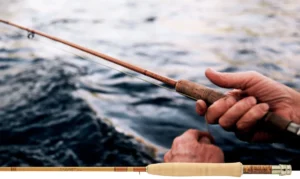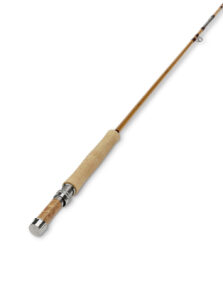
Key Takeaways
-
Lyle Dickerson was a master craftsman of bamboo fly rods, known for his precision and artistry.
-
Dickerson’s rods are highly sought after by collectors and anglers for their quality and the meticulous attention to detail in their creation.
-
Comparison of Popular Light Weight Dickerson Tapers For Smaller Stream Trout.
-
Authenticity and condition are paramount when collecting vintage rods, with restoration being a delicate process that can affect value.
The Art of Dickerson: Custom Rod Crafting
Crafting a bamboo fly rod is a blend of science and art. Each rod is unique, reflecting the personality and skill of its maker. Lyle Dickerson’s rods are no exception. They are the embodiment of his commitment to excellence and his understanding of an angler’s needs. Dickerson knew that a great fly rod should feel like an extension of the angler’s arm, and he built his rods with that philosophy in mind.
The Life and Influence of Lyle Dickerson
Lyle Dickerson was not just a rod maker; he was an innovator and a visionary in the field of fly fishing. Working out of Michigan, away from the traditional epicenters of fly rod craftsmanship, Dickerson developed a reputation for creating some of the finest bamboo fly rods ever made. His passion for fishing and rod making was evident in every rod that left his workshop.
The influence of Dickerson’s rods extends far beyond their initial creation. Today, they continue to inspire rod makers and anglers alike, serving as a standard for what a high-quality bamboo fly rod should be. Dickerson’s legacy lives on in the hands of those who cherish the tradition and artistry of fly fishing.
Signature Styles and Designs of Dickerson Rods
Each Dickerson rod is a masterpiece, but there are certain signature styles and designs that stand out. For example, Dickerson was known for his precise tapers— the gradual thinning of the rod from handle to tip—that gave his rods their distinctive action. The attention to detail in the node placement and the alignment of the bamboo strips are telltale signs of a Dickerson rod.
Moreover, the signature wraps, guides, and reel seats on Dickerson rods not only served functional purposes but also added to the aesthetic beauty of the rods. Collectors and anglers often seek out these details as marks of authenticity and craftsmanship.

The Dickerson Site https://dickersonrods.com/
Taper Talk: Crafting the Perfect Cast
The taper of a bamboo rod is its blueprint; it dictates everything from the rod’s flexibility to its strength. Crafting the perfect taper is a meticulous process, one that Dickerson mastered over his career. The right taper can make a rod feel alive in your hands, responsive to every subtle movement and nuance of the water.
Understanding tapers is essential for any serious angler or collector. It’s the taper that will tell you how the rod will perform on the water. Will it be delicate enough for dry fly fishing on a serene mountain stream? Or is it robust enough to handle the aggressive fight of a steelhead? These are the questions that the taper answers.
The Science of Tapers in Bamboo Fly Rod Design
The science behind tapers in bamboo fly rod design is a fascinating blend of physics and art. The taper determines how the energy from your cast travels down the rod and into the line. A steeper taper will result in a faster, more powerful cast, while a more gradual taper allows for a softer, more controlled presentation.
The taper affects not only the casting performance but also the feel of the rod. A well-designed taper will distribute the stress evenly throughout the rod, reducing the risk of breakage and ensuring the rod can handle the intended fish species and conditions. It’s a delicate balance, and one that Dickerson understood and executed with precision.
Lyle Dickerson’s Popular Light Weight Tapers Comparison
Summary Table:
|
Rod Nmae |
Dickerson 7012 |
Dickerson 8013 |
Dickerson 7613 v1 |
Dickerson 6611 (1948) |
|---|---|---|---|---|
|
Length (inches) |
84 |
96 |
90 |
78 |
|
Length (feet) |
7 |
8 |
7.5 |
6.5 |
|
Line Weight |
4 DT |
5 DT |
5 |
4 |
|
Number of Pieces |
2 |
2 |
2 |
2 |
|
Construction |
Hex |
Hex |
Hex |
Hex |
|
Ferrule 1 Size |
11/64 @ 42.00 in |
13/64 @ 48.00 in |
13/64 @ 45.00 in |
11/64 @ 39.00 in |
Dimension Table (in inches):
|
Station |
Dickerson 7012 |
Dickerson 8013 |
Dickerson 7613 v1 |
Dickerson 6611 (1948) |
|---|---|---|---|---|
|
0 |
0.062 |
0.074 |
0.068 |
0.064 |
|
5 |
0.076 |
0.082 |
0.090 |
0.075 |
|
10 |
0.090 |
0.095 |
0.104 |
0.090 |
|
15 |
0.105 |
0.114 |
0.122 |
0.105 |
|
20 |
0.120 |
0.129 |
0.140 |
0.120 |
|
25 |
0.134 |
0.145 |
0.155 |
0.137 |
|
30 |
0.149 |
0.160 |
0.170 |
0.147 |
|
35 |
0.160 |
0.170 |
0.180 |
0.162 |
|
40 |
0.171 |
0.180 |
0.198 |
0.170 |
|
45 |
0.195 |
0.189 |
0.208 |
0.180 |
|
50 |
0.203 |
0.215 |
0.213 |
0.188 |
|
55 |
0.213 |
0.232 |
0.220 |
0.196 |
|
60 |
0.229 |
0.251 |
0.238 |
0.206 |
|
65 |
0.242 |
0.272 |
0.256 |
0.220 |
|
70 |
0.262 |
0.293 |
0.274 |
0.230 |
|
74 |
0.304 |
– |
– |
– |
|
75 |
– |
0.304 |
0.288 |
0.285 |
|
80 |
– |
0.318 |
– |
0.285 |
|
85 |
– |
0.344 |
– |
– |
|
86 |
– |
0.350 |
– |
– |

The Dickerson Site https://dickersonrods.com/
Identifying Vintage Rods and Their Appeal
There’s something magical about holding a piece of angling history in your hands. Vintage bamboo rods, especially those crafted by masters like Lyle Dickerson, are not just tools for fishing—they’re heirlooms, each with a story to tell. The appeal of these rods goes beyond their functionality; they represent a bygone era of craftsmanship and attention to detail that many modern anglers yearn for.
Identifying a vintage rod, particularly a Dickerson, is a journey into the past. You’ll look for the classic signs: the rich patina of the bamboo, the hand-wrapped silk guides, and the distinct script of Dickerson’s signature. These rods were built to last, and finding one in good condition is a testament to the durability and timelessness of Dickerson’s work.
But it’s not just about the aesthetics. Vintage rods like Dickerson’s have a unique action that many modern rods can’t replicate. The way a bamboo rod bends and flexes with each cast and the delicate presentation it allows are unmatched. It’s a feel that’s as much about the experience as it is about catching fish.
-
Look for the quality of the bamboo and the condition of the varnish.
-
Examine the wrapping of the guides and the integrity of the ferrules.
-
Check for the maker’s mark—a Dickerson rod will often have his signature on the rod itself.
Modern Iterations: How They Compare
“While modern bamboo rods may use the same material as their vintage counterparts, the soul of a rod comes from the hands that made it.” – An experienced bamboo rod craftsman
Modern bamboo rod makers continue to draw inspiration from the likes of Dickerson. They use similar techniques and materials, but with contemporary twists. Advances in technology have allowed for more precise tapers and finishes, and some rod makers even incorporate carbon fiber or other modern materials into the design for added strength and flexibility.
However, there’s a debate among purists about whether these modern adaptations truly capture the essence of what makes a bamboo rod special. It’s a blend of tradition and innovation, and for many, the allure of a vintage Dickerson rod lies in its authenticity and the era it represents.
When comparing vintage to modern, consider these points:
– The craftsmanship and legacy imbued in a vintage rod often cannot be replicated.
– Modern rods may offer more consistent quality control and availability.
– The choice often comes down to personal preference and the intended use—whether it’s for fishing or collecting.
Comparing Dickerson Tapers to Contemporary Models
When comparing Dickerson’s tapers to contemporary models, it’s clear that his designs have stood the test of time. Modern rod makers often look to Dickerson’s tapers for inspiration, recognizing the genius in his designs. Yet, while modern tapers may benefit from computer-aided design and more precise manufacturing processes, there’s something to be said for the handcrafted nature of a Dickerson taper.
It’s not just about the measurements; it’s about the feel. Dickerson’s tapers were created with an intimate knowledge of how the rod would be used, reflecting a deep connection to the angling experience that can be hard to capture with modern, mass-produced rods.
Preserving Craftsmanship and Authenticity
Preserving the craftsmanship and authenticity of a bamboo fly rod is a responsibility that falls on both the maker and the collector. For those lucky enough to own a Dickerson rod, it’s about maintaining the rod’s condition and honoring the legacy of its creator.
This means proper storage, handling, and, when necessary, restoration. Restoration should be approached with caution, as it can significantly affect the rod’s value and authenticity. It’s a process that requires a skilled hand and a respect for the original maker’s work.
The Process of Restoration and Risks Involved
Restoration is a delicate dance between preserving the original integrity of the rod and making it functional for today’s anglers. It’s not just about making the rod look new again; it’s about retaining the soul of the rod. This means using period-correct materials and techniques, and avoiding alterations that would compromise the rod’s original character.
The risks involved in restoration are not trivial. A poorly restored rod can lose much of its value, both monetarily and sentimentally. Collectors should seek out restorers with proven expertise in working with vintage bamboo rods, and who understand the importance of maintaining authenticity.
In the end, whether you’re casting a line with a vintage Dickerson rod or admiring its craftsmanship from afar, it’s about connecting with the rich tradition of fly fishing. It’s about understanding and appreciating the work of masters like Lyle Dickerson, whose legacy continues to inspire and captivate anglers around the world.
The Process of Restoration and Risks Involved
When you restore a bamboo fly rod, you’re not just fixing an old piece of gear, you’re breathing life into a story. The process is as much about art as it is about craftsmanship. It starts with a thorough assessment of the rod’s condition—looking for signs of wear, checking the straightness of the bamboo, and ensuring the integrity of the joints. From there, it’s a careful process of cleaning, repairing, and sometimes replacing parts of the rod with period-correct materials.
But here’s the catch: every change you make can affect the rod’s value and collectability. The biggest risk? Losing the original character that makes a Dickerson rod so special. That’s why, when it comes to restoration, less is often more. Preserve the patina that tells the rod’s age and story. Replace only what’s necessary for the rod to function, and always use materials that match the original as closely as possible. It’s a tightrope walk between conservation and restoration, and it takes a steady hand and a reverent heart.
Ensuring Authenticity: Tips for Collectors
For collectors, the authenticity of a bamboo fly rod is paramount. It’s what separates the genuine from the replicas, the treasures from the trinkets. To ensure you’re getting a real Dickerson rod, start by doing your homework. Learn about Dickerson’s signature styles, his unique tapers, and the materials he used. Familiarize yourself with the markings and inscriptions that are hallmarks of his work.
Here’s a tip: always ask for provenance. Provenance is the rod’s history—who owned it, where it’s been, and any documentation that comes with it. It’s like a biography of the rod. The more you know about a rod’s past, the more confident you can be in its authenticity. And if you ever have doubts, don’t hesitate to consult with experts or reach out to the community of collectors. They can be your greatest resource in verifying the legitimacy of a Dickerson rod.

American Museum of Fly Fishing https://www.amff.org/portfolio/dickerson-fly-rod/
FAQs
What Makes Bamboo Fly Rods Special Compared to Modern Materials?
Bamboo fly rods are special for a few reasons. First, the material itself—bamboo is a natural fiber that has a unique combination of strength and flexibility. This gives bamboo rods a distinctive feel, or action, that many anglers believe can’t be matched by modern materials like graphite or fiberglass. Bamboo rods are often handcrafted, which means each one is slightly different and has its own personality.
How Can One Verify the Authenticity of a Dickerson Rod?
Verifying the authenticity of a Dickerson rod involves a few steps. First, look for the maker’s mark. Lyle Dickerson usually signed his rods, and his handwriting is distinctive. Next, check the craftsmanship. Dickerson’s attention to detail was meticulous, so uneven wraps or sloppy joints are red flags. Then, consider the rod’s provenance. A well-documented history can be a strong indicator of authenticity.
If you’re still unsure, reach out to a bamboo rod expert or a reputable dealer. They can provide an expert opinion on whether a rod is a genuine Dickerson. Additionally, comparing the rod to confirmed Dickerson rods can be helpful. Look at the taper, the guide spacing, and the overall build quality. A true Dickerson rod will stand out for its craftsmanship and attention to detail.
Most importantly, remember that a Dickerson rod carries a legacy. It’s not just a fishing tool; it’s a piece of history. That’s why verifying its authenticity matters—not just for the value it represents, but for the respect it pays to the craft.
The key to verifying authenticity lies in the details:
-
Examine the signature and compare it to known examples of Dickerson’s handwriting.
-
Look for the quality of craftsmanship that Dickerson is known for.
-
Research the rod’s history and ask for documentation.
What Are the Most Sought After Dickerson Rod Models?
Among the pantheon of Dickerson rods, certain models stand out as particularly coveted by collectors and anglers. The 8013, known for its versatile 8-foot length and delightful action, is a favorite for many. The 8014 Guide Special, with its robust build designed to handle the rigors of guiding, is another prized model. And then there’s the 7613, a shorter rod that’s perfect for small streams and delicate presentations.
These models are sought after not just for their performance on the water, but for their rarity and the stories they carry. Owning one of these rods is like owning a piece of fly fishing lore, a tangible connection to the golden age of rod making.
Are Modern Bamboo Rods Comparable to Vintage Dickerson Tapers?
Modern bamboo rods are the result of a blend of traditional techniques and contemporary advancements. While they can be comparable to vintage Dickerson tapers in terms of performance, there’s an intangible quality to a Dickerson rod that’s hard to replicate. The handiwork, the history, and the soul of a rod crafted by Lyle Dickerson himself—these are the elements that set his rods apart.
That being said, modern craftsmen who respect and emulate Dickerson’s methods can create rods that come close to the feel and performance of a vintage Dickerson. It’s a testament to the enduring impact of his work and the timeless nature of bamboo as a material for fly rods.
Among the pantheon of legendary fly rod makers, Lyle Dickerson stands out as a true artisan in the world of bamboo fly rods. His rods are known for their exceptional quality and performance, reflecting a legacy of craftsmanship that has inspired generations of custom rod makers. Collectors and anglers alike seek out Dickerson rods for their vintage appeal and enduring fishability, making them treasured pieces in the realm of fly fishing history.




